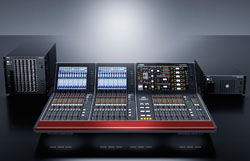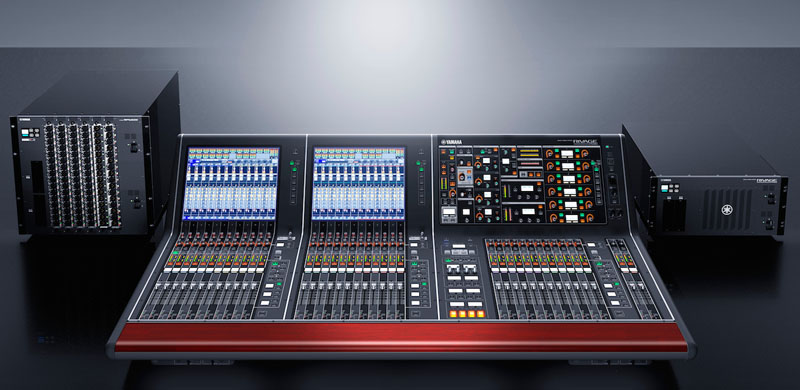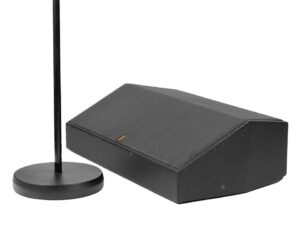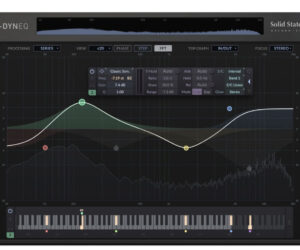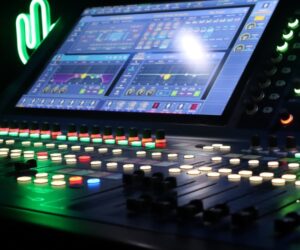Yamaha Corporation Japan has launched the RIVAGE PM10 digital mixing console, comprised of the CS-R10 control surface, DSP-R10 DSP engine, RPio622 I/O rack, three types of RY cards, and two types of HY cards to provide the flexibility to configure and match the scale and functional requirements of any application.
More than 10 years have passed since the Yamaha PM1D and PM5D helped define the digital console market, with the new RIVAGE PM10 significantly increasing the quality and versatility necessary in modern live sound environments.
“Our new flagship RIVAGE PM10 system is the result of more than 40 years of PM Series history and reinforces our passion to provide industry-leading commercial audio products,” states Laurence Italia, vice president/general manager, Yamaha Commercial Audio. “RIVAGE PM10 will ignite the market for a new era of extraordinary sound, operation, and reliability. Needless to say, RIVAGE PM10 would not be possible without the dedication of the Yamaha Japan R&D team as well as feedback from our customers.”
Under the fundamental philosophy of Yamaha live sound consoles, Hybrid Microphone Preamplifiers have been newly-developed, as has the analog section both in terms of components and overall design, achieving a pure, natural sound.
Precise models of the Rupert Neve Designs (RND) transformer circuitry and SILK processing have been created utilizing Yamaha’s VCM (Virtual Circuitry Modeling) technology. SILK processing includes selectable “RED” and “BLUE” characteristics, as well as a continuously variable “TEXTURE” knob that facilitates sonic shaping at the input stage, adding sparkle or power as required.
Josh Thomas, general manager of Rupert Neve Designs, states, “We’ve done a number of listening sessions to compare our hardware to the transformer and Silk Texture emulations that Dr. K of Yamaha Japan and the development team achieved. Rupert and I are both very impressed by how closely the emulations get to the original analog designs. We hope that you all enjoy the rich Rupert Neve sound.”
The channel EQ and dynamics have been upgraded with three newly developed algorithms plus the classic Yamaha “Legacy” algorithm. A new “Precise” algorithm includes Q parameters on the low and high shelving filters that allow filter overshoot to be flexibly controlled for added musical impact. An “Aggressive” algorithm has been designed for the most musical response, and a “Smooth” algorithm offers smooth, natural control while retaining the fundamental character of the source.
Two dynamics stages are provided, each functioning as a gate, compressor, ducker, or de-esser as required. Two compressor types are included: “Legacy Comp” features standard Yamaha digital console compressor characteristics; and “Comp260,” a VCM model of a popular analog comp/limiter from the mid-70s.
A total of 45 plug-ins are available for creative processing, with substantially increased processing power. New and noteworthy are plug-ins created in collaboration with Rupert Neve Designs, TC Electronic, and Eventide.
Collaboration with Rupert Neve Designs has resulted in the “Rupert EQ 773,” “Rupert Comp 754,” “Rupert EQ 810,” and “Rupert Comp 830,” all VCM models of Neve designed outboard devices from the 70s and 80s. All four models deliver the musical vintage outboard sound still favored by many engineers.
The alliance with TC Electronic has resulted in the inclusion of two new reverb plug-ins: the “VSS4HD” room simulation reverb that offers a multitude of reflection settings with musical-sounding reverb processing capabilities; and the “NON LIN2” plug-in that can function as an envelope-filtered gate reverb without requiring a trigger.
“I wish to congratulate Yamaha with raising the bar for live console design significantly,” says Thomas Lund, CTO of TC Electronic. By directly integrating the world’s finest EQ, dynamics and reverbs, this mixing system is truly outstanding. Therefore, a big congratulations to the users also.”
Cooperation with Eventide has produced the “H3000-LIVE” harmonizer, an accurate reproduction of the H3000 Ultra Harmonizer algorithm with an interface streamlined for live sound use. “The marriage of classic Eventide effects with the state-of-the-art Yamaha RIVAGE PM10 mixing system is a match made in heaven,” notes Ray Maxwell, Eventide vice president of sales and marketing.
Console operation has been given the ample attention as well, with the Yamaha-familiar Selected Channel section implemented in full, allowing all parameters of the selected channel to be directly and intuitively controlled. There are also two large LCD touch screens that provide logical continuity with the faders, offering the same operability as the Centralogic interface in 12-channel groups.
In addition to this dual interface hybrid operation style, horseshoe-ring encoder position indicators, refined panel layout, and several other details contribute to significantly improved overall operability.
New features extend the usefulness of the scene memory: “Isolate” enables the engineer to specify entire channel modules including EQ and dynamics libraries, etc., that will be protected from recall operations without altering the Recall Safe settings, which is significant for situations where scene memory is heavily used.
The Overlay Filter can be “overlaid” on a current mix to apply temporary offsets to fader and mix/matrix send levels independently from Scene Recall, valuable in situations that require sudden changes and the ability to easily revert to the original settings.
The CS-R10 control surface and DSP-R10 DSP engine are connected via a dedicated Cat-5e ring “Console Network.” The DSP engine connects to the RPio622 I/O racks via the newly developed TWINLANe ring network using multi-mode optical fiber. The fact that both networks use simple ring connections facilitates redundancy and reliability.
TWINLANe is an original Yamaha protocol that can handle up to 400 96 kHz audio channels over distances of up to 300 meters with low latency and redundancy for high reliability. Up to two DSP-R10 DSP engines and eight RPio622 I/O racks can be connected in a single ring.
Connection to a computer for multi-track recording, connectivity to the NUAGE advanced production system, Yamaha CL and QL Series consoles, as well as other external equipment is possible via a Dante network. Dante works with TWINLANe to create an exceptionally flexible, reliable system.
The new RIVAGE PM10 console has an expected delivery during 2015.


